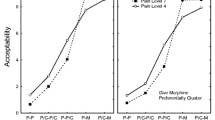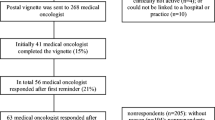Abstract
Following clinical observations showing that opiates are sometimes not consistently administered for chronic cancer pain, a survey was conducted among 1200 physicians in the German-speaking part of Switzerland. Their opium-prescribing habits were assessed by means of a postal questionnaire. The results indicate that, among the majority of physicians completing the questionnaire, established guidelines and basic principles of pain control with opiates in cancer patients are largely understood. Oral morphine is chosen by 89% to initiate treatment of chronic cancer pain, and the correct use of slow-release morphine is known to 87% of the responding physicians. Unfortunately, an important minority of physicians does not follow established guidelines in the treatment of cancer pain, and up to 20% still feel that the danger of addiction, respiratory depression and other side-effects are important reasons for withholding opiates in this patients population. The results and their implications are discussed and compared with the current literature on cancer pain management.
Similar content being viewed by others
References
Bonica JJ (1978) Cancer pain: a major national health problem. Cancer Nurs 1:313–316
Daut RL, Cleeland CS (1982) The prevalence and severity of pain in cancer. Cancer 50:1913–1918
Eliott TE, Eliott BA (1992) Physicians attitudes and beliefs about use of morphine for cancer pain. J Pain Symptom Manage 7:141–148
Foley KM (1984) The treatment of cancer pain. N Engl J Med 313:84–95
Hanks GW (1989) Controlled-release morphine (MST Contin) in advanced cancer. Cancer 63:2378–2382
Marks RM, Sachar EJ (1973) Undertreatment of medical inpatients with narcotic analgesics. Ann Intern Med 78:173–181
Porter J, Jick H (1980) Addiction rate in patients treated with narcotics. N Engl J Med 302:123–130
Senn HJ (1990) Das Schmerzproblem in der Onkologie. Schweiz Med Wochenschr 120:1135–1142
Sorge J, Lehmkuhl C, Lohse K, Hermann H, Pichelmayer I (1990) Langzeittherapie von Tumorschmerzen mit Morphinretard-Tabletten. Med Klin 9:523–528
Stiefel F, Morant R (1991) Morphine intoxication during acute reversible renal insufficiency. J Palliat Care 7:45–47
Twycross RG, Lack SA (1990) Therapeutics in terminal care, 2nd edn. Churchill Livingstone, Edinburgh London New York
Ventafridda V, et al (1987) A validation study of the WHO method for cancer pain relief. Cancer 59:851–856
Warfield CA (1991) Guidelines for the use of MS Contin tablets in the management of cancer pain. Postgrad Med J 67 [Suppl 2]:9–13
White ID, Hoskin PJ, Hanks GW, Bliss JM (1991) Analgesics in cancer pain: current practice and beliefs. Br J Cancer 63:271–274
World Health Organization (1990) Cancer pain relief and palliative care. WHO Tech Rep Ser 804:7–10
Zenz M, Strumpf M, Tryba M, Röhrs E, Steffmann B (1989) Retardiertes Morphin zur Langzeittherapie schwerer Tumorschmerzen. Dtsch Med Wochenschr 114:43–47
Author information
Authors and Affiliations
Rights and permissions
About this article
Cite this article
Stiefel, F., Morant, R., Radziwill, A. et al. Attitudes of Swiss physicians in prescribing opiates for cancer pain. Support Care Cancer 1, 259–262 (1993). https://doi.org/10.1007/BF00366046
Issue Date:
DOI: https://doi.org/10.1007/BF00366046




